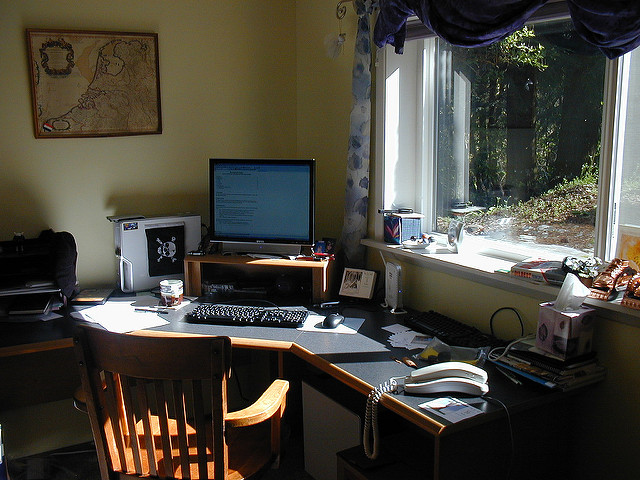
by rossanahead | Feb 7, 2017 | Business Tips, career, family
Pursuing a career or managing a business while raising a family puts unbelievable demands and pressure on women, and if one is not careful, this can lead to serious health issues.
Needless to say, we must never put our health and well-being at the bottom of our list of priorities. Always keep in mind that a healthy body is key to enabling you to carry out all of your daily tasks and responsibilities. As inspirational speaker Joyce Meyer put it: “I believe that the greatest gift you can give your family and the world is a healthy you.”
The good news is that with time management, you can always fit some exercise into your hectic schedule. Get as much physical activity in your work and home life as you can, and you’ll soon see an improvement in your stamina, productivity, and energy levels—guaranteed!
Wake up earlier
Try getting up earlier than usual on most days for some quiet “me time” and about 15 to 30 minutes of exercise. To ensure you focus on yourself during this period, prepare the breakfast and other needs of your children the night before. When the kids finally wake up, you’ve already worked up a sweat or enjoyed an invigorating run around the neighborhood.
Adopt an efficient exercise plan
Choose a workout program that can be performed quickly with little preparation, but yields maximum results in a shorter period of time. With such an exercise routine, it’s easy to sneak in your moves anytime and anywhere. Running and high-intensity workouts are some exercises that can be a good fit for your lifestyle.
Use what’s available
Whether you are trying to lull your baby to sleep at home or finishing paperwork at the office, use the things and furniture around you to reach your fitness goals. For instance, use your chair to perform stretching or bending exercises. Or you can invest in a yoga mat and do some planking positions or stretching exercises. And, yes, you can do this at the office, too.
Invest in dumbbells, bands, jump ropes
These pieces of exercise equipment can help speed up your heart rate and improve your blood circulation. While at home watching TV, pick up your dumbbells during commercial breaks and just flex your muscles. During a 30-minute sitcom, for example, you can get in nine minutes of exercise on average.
Make it fun
Who says exercise has to be boring and tedious? If you are not really into working out, consider other activities that appeal to you. Perhaps you’d like to enroll in a dance class or take yoga lessons or pick up a sports activity like boxing. These days there are tons of opportunities to get fit, so explore what’s out there and give it a try.
Escape during lunch time
Before or after taking your lunch, head out for some brisk walking outdoors for a mental and physical pick-me-up. When you return to work, make sure you have enough supply of fruits and raw vegetables, meal bars, or protein shakes for healthy snacking. This is a neat way to burn off extra calories and fill up on healthy food.
Include your family
What better way to exercise than to invite your husband and kids to join you in your quest for a healthy lifestyle? You’re all not only getting fitter, you’re all also getting closer to one other. Indeed, the family that jogs, walks, bikes, or treks together, stays together.
Photo: Claire Griffiths

by rossanahead | Feb 2, 2017 | Business Tips, career, Education
By Ruth Manimtim-Floresca
You’ve probably heard the story of how Thomas Edison failed more than a thousand times before he finally produced a light bulb that works. Instead of looking at failures as mistakes, Edison acknowledged them as a successful discovery of 1,000 ways to not make a light bulb.
Throughout history, Edison and many other great men and women have proven that we can always “fail forward.” Their stories teach us that no one can be a total loser as long as one keeps trying. Here are uplifting lessons to keep in mind when setbacks threaten to dampen your spirit.
- Let failure refine—not define—you. For people with a teachable heart, committing and acknowledging mistakes enables them to turn pride into humility that, in turn, develops their character.
- Never associate setbacks with complete failure. Although not succeeding is surely disheartening, wallowing in self-pity for long will not help you move forward. Get up and try again.
- Consider failure as a stepping stone. Everyone is bound to fail at some point, but those who persist despite stumbling are the ones that usually succeed. Read up on famous people like Walt Disney, Isaac Newton, Charlie Chaplin, and J.K. Rowling to find the inspiration you need to keep going.
- Treat failure as a learning experience. Before making another attempt, evaluate your past actions, reflecting on what went right and what did not. Take note of what to avoid doing or what to do differently the next time around.
- Allow failure to help you pinpoint priorities and values. When you fail, you are forced to inventory what truly matters to you and to make the needed adjustments. One mistake people may make is focusing on the wrong things. If you value the right things, it often becomes easier to succeed because you have the passion and determination to chase after your dream.
- Consider if you need to seek help. Being self-sufficient may not always be the right approach. It won’t hurt to ask for and accept assistance from trusted partners. As the saying goes, “Two heads are better than one,” and that often applies to many situations.
- Credit failure for improving your financial perspective. Major debacles will force you to look at money-related things differently. Losing money through bad decisions will remind you to treat your finances with more care. As your decision-making skills improve, you’ll be creating a stronger foundation for future wealth and success.
- Thank failure for filtering out superficial friendships. Unfortunately, there are people who stick around only if they can get something from you and who disappear once you fall. While betrayal hurts, be comforted in the knowledge that true friends will not care about how much money you have or how you can continue to be of use to them. Know that real friends stay and motivate you to get back on your feet.
Ultimately, failure reminds us to look to a higher power for comfort and guidance. Personally, I rest my faith in God, knowing that everything happens for a reason and that failure teaches me lessons I wouldn’t otherwise learn if things always went smoothly.
Photo: Leonardo Shinagawa

by rossanahead | Jan 31, 2017 | Business Tips, career
If you’ve been lamenting how much hassle it is to travel to work and deal with the nightmare traffic, the pushing crowds, the pollution, and the heat, the good news is that employers in the Philippines seem to be more open to the idea of flexible work arrangements, or FWAs.
Mary Grace Riguer, OIC-executive director of the Institute for Labor Studies, an attached agency of the Department of Labor and Employment (DOLE), said in a recent business forum that more and more employers in the Philippines have begun adopting FWAs, such practices now made more feasible by technological and telecommunications breakthroughs.
“In the Philippines there are some players already [engaging in FWAs],” confirmed Riguer, mentioning Metro Pacific Investments which implements flexi time and work from home arrangements, and Aboitiz Equity Ventures which has adopted flexi time and earlier-shift schedules.
Meralco is now also implementing telecommuting, launching its pilot last year and currently planning to expand the coverage of the program, said Paola Verayo, an HR business partner at the company, in her presentation in the same gathering.
Riguer said some fields in the services sector are a particularly good fit for FWAs. These include industries engaged in medical health, computer and IT, marketing, communications, customer service, sales, administration, education and training, and finance.
Meanwhile, among jobs or occupations that may adapt well to FWAs are online teaching, customer support, web and software development, administration, sales and marketing, engineering, design and multimedia, mobile development, writing, accounting and bookkeeping, networking, and business services.
As long as the work or some aspects of work will be using technology, it is possible for the employee to be allowed to work from the house or anywhere outside of work premises, said Riguer.
She said forms of flexible work arrangements that are currently being applied in the country include telecommuting (working from home), telework (taking home some of your office work), virtual or freelance work (working full-time away from the workplace), and crowdsourcing (outsourcing jobs online to groups of people who operate independently).
Interest in telecommuting and other forms of flexible work practices is rising amid the terrible road congestion in Metro Manila and the growing desire of workers for a more equitable work-life balance.
A study conducted by the Japan International Coordination Agency foresees the traffic costs in Manila increasing to P6 billion a day by 2030 from P2.4 billion per day in 2015.
Last year, Senator Jose Villanueva, chairman of the Senate Committee on Labor, Employment, and Human Resources Development, filed Senate Bill No. 1033, or the Telecommuting Act of 2016, on August 16, 2016.
The bill encourages employers to allow “telecommuting” or the “partial or total substitution of computers or telecommunication technologies, or both, for the commute to work by employees.”
On January 25, said Riguer, DOLE made a representation before a Senate hearing in support of the intent of the bill, noting that by institutionalizing telecommuting, the legislation can provide protection to telecommuting employees.
She added that benefits for the government of telecommuting include reduced road traffic and pollution, while employers stand to gain from greater worker productivity, lower employee turnover, and a deeper talent pool.
Employees, on the other hand, can enjoy benefits such as reduced travel time, greater flexibility, higher autonomy, and increased work satisfaction and motivation. -RCA
Photo: Mike

by rossanahead | Jan 19, 2017 | career, Education, Existing Business, feature
By Rowena Diocton
“Wala ka pang boyfriend? (You don’t have a boyfriend yet?)” and “Kailan ka magpapakasal? (When are you getting married?)” are only two of the typical questions Filipino women are asked during family reunions. Because of this, many Filipinas dread going to reunions or reading their aunts’ comments on social media.
Despite the hype on women’s empowerment, some Filipinas stay bound to self-limiting beliefs, such as that women should scramble to get married and have children. Their dreams are limited to boxes in the spectrum of “child rearing,” “budgeting,” and “housekeeping.”
They are also expected to marry earlier than men. On average, most Filipino women get married at 24, while men get married at 27, according to the World Economic Forum Gender Gap Index 2015. The report also reveals that five out of 100 women (5%) marry between 15 and 19 years of age.
Even societies abroad generally view Filipino women with less regard than they’re worth. “Dating,” “marriage,” and “scandals” are only a few of the top results when you type “Filipina,” “Filipino woman,” or “Pinay” on a quick Google search. It seems the world seeks Filipinas either to marry or to spend a good time with. Somehow, their other contributions to the world are buried.
It’s already 2017, so why are a number of Filipinas still stuck in this outdated box? Here are four ways to step up and join the ranks of the 21st-century Filipina superwomen this year.
Be Part of Positive Social Change
If Concepcion Felix-Calderon and Pura Villanueva Kalaw of Asociacion Femenista Filipina had sat idly by during the first half of the 20th century, Filipino women wouldn’t be enjoying the right to vote that we do today. We need to be part of something bigger than ourselves. So ask yourself: What can I offer to society to make it more just?
Rethink the Way You Treat Your Body
In Asia, social and economic growth has sadly coincided with the rise of eating disorders. Access to social media sites has allowed real-time body-shaming comments against celebrities like Jessy Mendiola and Ina Raymundo. This year, resolve to embrace a more positive body image and join body positive movements like plump.ph and #blackgirlmagic—and start something confidently beautiful within yourself.
Dip into the Wealth of Available Data
At least 4.66 billion Web pages were reportedly online as of mid-March 2016. Roughly 130 million books have been written as of 2010, according to Google. Anyone can now take massive open online courses at her own time, thanks to sites like Coursera, Edx, Khan Academy, TED-Ed, Udacity, Udemy, Lynda, and a lot more. Using available information, why not join important discourses that can affect the Filipina way of life and let your opinion be heard?
Sit at the Career Table
In several countries in the Asia Pacific, men often get 15% to 30% more in annual base pay than women, with females excluded in part due to the nature of the job, manager bias, and workforce policies. While it’s vital that organizations address the disparity, we can also play our part.
In 2010, Facebook COO Sheryl Sandberg discussed the reasons why there are too few women leaders. Filipina career women should take Sandberg’s cue and learn to negotiate for ourselves at work, delegate equal tasks to our partners at home, and kick ass at work even as we plan for a family.
While one year may not be enough to produce a radical change in you or in society, this year is a good place to start taking gradual steps. Your elders may keep asking you about your single or family life, but this time you’ll have a fuller answer to give. Your male colleagues may still get paid more, but you’re already taking on the training needed to move up. Trying and not reaching your goals is not failure; what can set you up for failure is not having holistic and resilient goals toward self-empowerment.
Photo: Ali Edwards

by rossanahead | Jan 15, 2017 | Recent Posts
While the term “millennial” is oftentimes broadly equated with words like “entitled“ “spoiled,” and “narcissistic,” many millennials are in fact bucking this stereotype—they are showing in their own special and pioneering way that they’re doing more than their fair share in helping shape a better tomorrow for humankind.
Let’s meet three young Filipinas who are proving critics of millennials wrong as they strive to make their mark as social entrepreneurs in their chosen fields of endeavor.
When she was 13, Mica Tan started trading stocks and at 19, she formed her own distribution business. At 21, she established MFT Group of Companies, a financial holdings firm that provides financial assistance to other companies.
“In just a span of a year and a half, MFT has already undergone a whole lot of changes,” Mica says. “We started with two companies under our belt and now we have expanded to nine and are still growing. Our company focuses on angel investing which provides tailor-made funding to empower, as of the moment, nine businesses (some of them as old as forty years) to achieve their goals. These firms are engaged in diverse businesses and fields including manufacturing, publishing, film production, agriculture, and soon, pharmaceuticals.”
Mica adds that “with every company that joins or opens up to a young group like us, we see it as a way for us to also grow personally and professionally.”
In her first year in high school, Alexandra “Alex” Eduque got involved with Habitat for Humanity through a school project in which she was assigned to volunteer her services in helping to build homes for the underprivileged in a community in Amadeo, Cavite.
The weeklong experience made a huge impression on her, she recalls. “I remember enjoying it so much and finding so much fulfillment in what I was able to accomplish that week, and thought to myself that if I got involved even more and shared more of my time, I would be able to help out even more than I already had.”
“That summer, I took it upon myself to contact the Habitat for Humanity headquarters in the Philippines and a few weeks later, I found myself building homes in Baseco, Tondo, Manila. For two months, I went there every day and engaged in a multitude of construction tasks, alongside making friends with the community.”
From there, Alex has moved on to found her own organizations, such as Move.org Foundation, Inc., also known as MovEd (Molding Optimism and Values through Education), an offshoot of her undergraduate thesis work at Barnard College in New York. MovEd provides early childhood care and development programs in underserved communities through holistic education, providing children with the foundation to succeed in school.
When Tal de Guzman of Risqué Designs by Tal was studying fashion and accessories design, she realized that most Filipino designers were focused on apparel, bags, or jewelry. She noted that Filipino shoe designers were rare, and even rarer were those who used local materials in their creations. She found this scarcity to be an opportunity worth exploring.
And so Risqué Designs by Tal, her first business venture, was formed. “Most brands are content with using conventional materials such as leather, suede, canvas and lace,” she says. “But the Philippines has a rich array of textiles. Risqué uses handwoven fabrics from different parts of the country, but now mostly focuses on the traditional art of hablon-making in Valladolid, Negros Occidental. We not only use this fabric in our designs, but we also help our hablon weavers improve their income—this is part of our advocacy.”
Tal adds that many of her shoe designs are outrageous enough to make people do a double take and question if they are wearable or not (they are). “I like pushing boundaries with my designs, making use of materials in ways that haven’t been used before for shoes,” she says.
Because of her unique designs, Tal has been the recipient of different recognitions and awards. “Somehow it feels like a sort of validation, in terms of the concept and the business,” she says. “It propels me to move forward and do more.”
Photo: Pabak Sarkar





